Learning about the changes that occur on a cometary surface over time was a primary goal of the European Space Agency’s Rosetta mission, which orbited comet 67P/Churyumov-Gerasimenko between August 2014 and September 2016. This was a period when the comet was swinging through the inner Solar System as it closed to perihelion. Now we have vivid evidence of the changes the comet experienced as recorded by Rosetta.
Consider a report in Nature Astronomy, which chronicles outburst activity on the comet associated with the spectacular collapse of a cliff face. Located in the Seth region of the comet on a prominent cliff edge was a 70-meter long fracture about 1 meter wide. During the period of observation, as Rosetta drew ever nearer perihelion, buried ices turned to vapor at an increasing rate, pulling dust out into space, with occasional outburst activity. Rosetta observed an outburst on July 10, 2015 that was associated with this region.
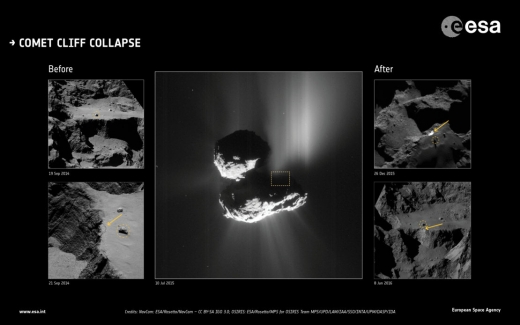
Image: Comet cliff collapse before and after. Credit: ESA.
A scant five days later, the place where the fracture had been now showed a bright, sharp edge, with a host of meter-sized boulders at the foot of the 134-meter high cliff that had not been there before. The assumption is that the cliff collapse and outburst were linked. Water ice buried deep inside the comet was thus exposed, to gradually turn to vapor in the following months. The exposed face was found to be six times brighter than the average surface brightness of the cometary nucleus in the period immediately after the event.
Activity like this has a profound effect on the cometary surface. As this ESA news release explains, the material that fell from the cliff and accumulated at its foot weighs in at about 10,000 tonnes, with about 100 tonnes being lost into space. “We see a similar trend at the foot of other cliffs that we have not been so fortunate to have before and after images, so this is an important validation of cliff collapse as a producer of these debris fields,” says Maurizio Pajola (NASA Ames/University of Padova, Italy), who led the new study.
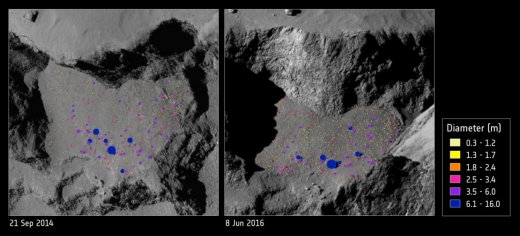
Image: Fallen cliff debris. Credit: ESA.
Researchers believe that daily and seasonal temperature variations may have driven fractures deeper into the subsurface of the comet than was previously thought, making it more vulnerable to the temperature changes of its journey into the inner system. What we have here is a priceless look before and after a major event, confirming the importance of cliff collapses in molding the surface of a comet and perhaps provoking outburst activity. Adds Pajola:
“If the fractures permeated volatile-rich layers, heat could have been transferred to these deeper layers, causing a loss of deeper ice. The gas released by the vapourising material could further widen the fractures, leading to a cumulative effect that eventually led to the cliff collapse. Thanks to this particular event at Aswan, we think that the cumulative effect led by strong thermal gradients could be one of the most important weakening factors of the cliff structure.”
We also have a new study in Science examining the broad range of terrain change on Comet 67P during Rosetta’s two years of close observation. Here numerous processes appear to be at work, each with the potential for working serious change. In situ weathering involves the weakening of materials through the heating and cooling cycle, both daily and seasonal, that can result in gas outflows and cliff collapses like the one we just examined. But we also have forces created by the comet’s spin rate as it moved toward perihelion, thought to have created a new fracture observed by Rosetta.
A previously known fracture some 500 meters long runs through the comet’s neck in the region called Anuket. Although observed in August of 2014, the fracture was found to have become extended by another 30 meters by December of that year. And by June of 2016, the new fracture, 150 to 300 meters long, had opened parallel to the original fracture.
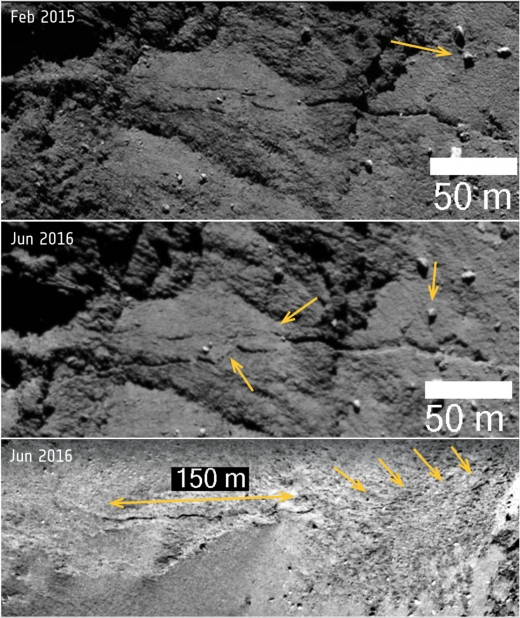
Image: Comet changes: new fracture and boulder movement in Anuket. Credit: ESA.
We also see movement in boulders on the surface of Comet 67P, perhaps linked to the fracture activity, perhaps not. In one case, a boulder 30 meters wide and weighing 12,800 tonnes was observed to have moved 140 meters in the comet’s Khonsu region. This movement is thought to have occurred during the perihelion period, when several outbursts were observed close to the boulder’s position. Erosion of the nearby surface could be the culprit here, allowing the boulder to roll downslope. Equally possible: A strong outburst could have lifted it to its new location.
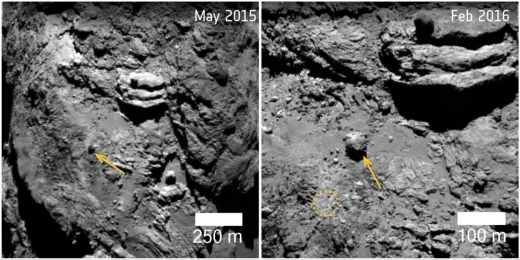
Image: Comet changes: A moving boulder in Khonsu. Credit: ESA.
Sublimation is a major cause of erosion, as is falling dust returning to the surface after an outburst, both of which can sculpt the cometary landscape. In some areas, scarps in several smooth plains have been seen to retreat by tens of meters — as much as a few meters a day during perihelion. Meanwhile, in regions of smooth plains like Comet 67P’s Imhotep, new circular features are found that were once obscured by surface material. The likely cause here is sublimation of underlying ice, which has removed up to 3 meters of material in one area.
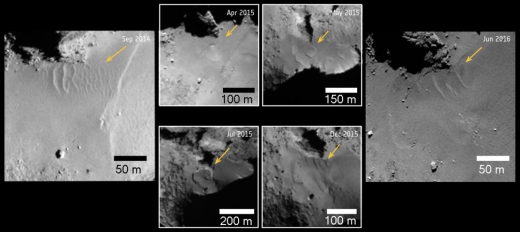
Image: Comet changes: Ripples and scarps in Hapi. Credit: ESA.
The movement on the surface of the comet is strikingly swift. In the comet’s neck region, a smooth area once likened to sand dunes on Earth when first observed, ripple formations began showing expanding circular features that reached diameters of 100 meters over a period of three months. These then faded and gave rise to new sets of ripples. In addition, honeycomb-like features have been observed in the Ma’at region on the comet’s northern hemisphere, showing a marked increase in roughness as perihelion approached.

Image: Comet changes: surface textures in Ma’at. Credit: ESA.
Rosetta shows us that this comet’s surface is geologically active on short and long time-frames, although its overall appearance has not significantly changed, based on ground-based studies conducted over the last few years. Ramy El-Maarry (University of Colorado, Boulder), who led the study, speculates that earlier perihelion passages were far more active, when the comet would have held a higher amount of volatiles and the major landforms on the surface would have attained their current configuration. Whatever the case, Rosetta’s study of Comet 67P’s changing surface vividly shows a surface of growing fractures, evolving cliffs and boulders in motion, a scene we had expected but are now able to analyze in detail for the first time.
The paper on the cliff collapse is Pajola et al., “The pristine interior of comet 67P revealed by the combined Aswan outburst and cliff collapse,” published online by Nature Astronomy 21 March 2017 (full text). The El-Maarry et al. paper is “Surface changes on comet 67P/Churyumov-Gerasimenko suggest a more active past,” published online by Science 21 March 2017 (abstract). This ESA news release is also helpful.



It seems counterintuitive to read about falls and collapses on a body with a gravity of about 1/5000 g. Nevertheless, this may well be an accurate description of low strength material in such a weak gravitational field.
The image showing exposed water ice below the surface is a nice bisual confirmation that comets acquire their dusty surfaces as a residue after the volatiles escape, insulating the interior. Those water interiors may be the key to opening up the solar system as sources of propellant, rocket fuel, and water for life support.
And earlier arviv paper measuring slopes and estimating material strength:
Gravitational slopes, geomorphology, and material strengths of the nucleus of comet 67P/Churyumov-Gerasimenko from OSIRIS observations
Earth owes its xenon to comets:
http://sci.esa.int/rosetta/59177-rosetta-finds-comet-connection-to-earth-s-atmosphere/
https://cosmosmagazine.com/geoscience/much-of-earth-s-xenon-was-delivered-by-comets
Bizarro Comet Challenging Central Florida Researchers
By zkotala
Thursday, June 29, 2017
Scientists pursue research through observation, experimentation and modeling. They strive for all of these pieces to fit together, but sometimes finding the unexpected is even more exciting.
That’s what happened to University of Central Florida’s astrophysicist Gal Sarid, who studies comets, asteroids and planetary formation and earlier this year was part of a team that published a study focused on the comet 174P/Echeclus. It didn’t behave the way the team was expecting.
“This is another clue that Echeclus is a bizarre solar system object,” said University of South Florida physics research Professor Maria Womack, who leads the team.
Full article here:
https://today.ucf.edu/bizarro-comet-challenging-central-florida-researchers/
To quote:
The team found that the levels of carbon monoxide were nearly 40 times lower than typically expected from other comets at similar distances from the sun. This suggests that Echeclus and similar active Centaurs may be more fragile than other comets. Echeclus may have gone through a different physical process from most comets that caused it to lose a lot of its original carbon monoxide, or it may have had less of that substance to begin with.
Understanding the composition of comets and how they work will help researchers understand how our solar system was formed. It will also aid space explorers plan for their travels – things to avoid and perhaps hidden resources found within the nucleus of comets that may be useful on deep space missions.
Unexpected surprise: a final image from Rosetta
28 September 2017
Scientists analysing the final telemetry sent by Rosetta immediately before it shut down on the surface of the comet last year have reconstructed one last image of its touchdown site.
After more than 12 years in space, and two years following Comet 67P/Churyumov–Gerasimenko as they orbited the Sun, Rosetta’s historic mission concluded on 30 September with the spacecraft descending onto the comet in a region hosting several ancient pits.
Full article and image here:
http://www.esa.int/Our_Activities/Space_Science/Rosetta/Unexpected_surprise_a_final_image_from_Rosetta
eso1732 — Science Release
ALMA and Rosetta Detect Freon-40 in Space
Dashing Hopes that Molecule May be Marker of Life
2 October 2017
Observations made with the Atacama Large Millimeter/ submillimeter Array (ALMA) and ESA’s Rosetta mission, have revealed the presence of the organohalogen Freon-40 in gas around both an infant star and a comet. Organohalogens are formed by organic processes on Earth, but this is the first ever detection of them in interstellar space. This discovery suggests that organohalogens may not be as good markers of life as had been hoped, but that they may be significant components of the material from which planets form. This result, which appears in the journal Nature Astronomy, underscores the challenge of finding molecules that could indicate the presence of life beyond Earth.
http://www.eso.org/public/news/eso1732/?lang